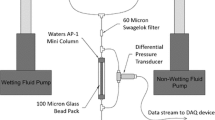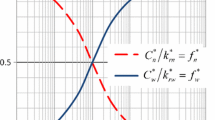Abstract
Motivated by the need to determine the dependencies of two-phase flow in a wide range of applications from carbon dioxide sequestration to enhanced oil recovery, we have developed a standard two-dimensional, pore-level model of immiscible drainage, incorporating viscous and capillary effects. This model has been validated through comparison with several experiments. For a range of stable viscosity ratios (M = μ injected,nwf/μ defending, wf ≥ 1), we had increased the capillary number, N c and studied the way in which the flows deviate from fractal capillary fingering at a characteristic time and become compact for realistic capillary numbers. This crossover has enabled predictions for the dependence of the flow behavior upon capillary number and viscosity ratio. Our results for the crossover agreed with earlier theoretical predictions, including the universality of the leading power-law indicating its independence of details of the porous medium structure. In this article, we have observed a similar crossover from initial fractal viscous fingering (FVF) to compact flow, for large capillary numbers and unstable viscosity ratios M < 1. In this case, we increased the viscosity ratio from infinitesimal values, and studied the way in which the flows deviate from FVF at a characteristic time and become compact for non-zero viscosity ratios. This crossover has been studied using both our pore-level model and micro-fluidic flow-cell experiments. The same characteristic time, τ = 1/M 0.7, satisfactorily describes both the pore-level results for a range of large capillary numbers and the micro-fluidic flow cell results. This crossover should lead to predictions similar to those mentioned above.
Similar content being viewed by others
References
Abramoff M.D., Magelhaes P.J., Ram S.J.: Image processing with Image. J. Biophotonics Int. 11, 36–42 (2004)
Blunt M., King P.: Macroscopic parameters from simulations of pore scale flow. Phys. Rev. A 42, 4780–4787 (1990)
Daccord G., Nittmann J., Stanley H.E.: Radial viscous fingers and diffusion-limited aggregation: fractal dimension and growth sites. Phys. Rev. Lett. 56, 336–339 (1986a)
Daccord G., Nittmann J., Stanley H.E.: Fractal viscous fingers: experimental results. In: Stanley, H.E., Ostrowsky, N. (eds) On Growth and Form, pp. 203–210. Martinus Nijhoff Publisher, Dordrecht (1986b)
Duffy D.C. et al.: Rapid prototyping of microfluidic systems in poly(dimethylsiloxane). Anal. Chem. 70, 4974–4984 (1998)
Dullien F.A.L.: Porous Media: Fluid Transport and Pore Structure. Academic Press, New York (1979)
Ferer M., Smith D.H.: Dynamics of growing interfaces from the simulation of unstable flow in porous media. Phys. Rev. E 49, 4114–4120 (1994)
Ferer M. et al.: The fractal nature of viscous fingering in two-dimensional pore level models. AIChE J 41, 749–763 (1995)
Ferer M., Gump J., Smith D.H.: The fractal nature of viscous fingering in three-dimensional pore-level models. Phys. Rev. E 53, 2502–2508 (1996)
Ferer M., Bromhal G.S., Smith D.H.: Pore-level modeling of immiscible drainage: validation in the invasion percolation and DLA Limits. Physica A 319, 11–35 (2003)
Ferer M. et al.: Crossover from capillary fingering to viscous fingering for immiscible unstable flow: experiment and modeling. Phys. Rev. E 70, 016303 (2004)
Ferer M., Brohmal G.S., Smith D.H.: Two phase flow in porous media: crossover from capillary fingering to compact invasion for drainage. Phys. Rev. E 71, 026303 (2005)
Ferer M., Bromhal G.S., Smith D.H.: A pore-level model of drainage with stable viscosity ratios: crossover from fractal capillary fingering to compact flow. Phys. Rev. E 76, 046304 (2007a)
Ferer M., Bromhal G.S., Smith D.H.: Crossover from capillary fingering to compact invasion for two-phase drainage with stable viscosity ratios. Adv. Water Resour. 30, 284–299 (2007b)
Ferer M., Brohmal G.S., Smith D.H.: Miscible viscous fingering in three dimensions: fractal-to-compact crossover and interfacial roughness. Phys. Rev. E 80, 011602 (2009)
Fernandez J.F., Rangel R., Rivero J.: Crossover length from invasion percolation to diffusion limited aggregation in porous media. Phys. Rev. Lett. 67, 2958–2961 (1991)
Frette O.I. et al.: Immiscible displacement of viscosity-matched fluids in two-dimensional porous media. Phys. Rev. E 55, 2969–2975 (1997)
Jensen M.H., Mathiesen J., Procaccia I.: Convergent calculation of the asymptotic dimension of diffusion limited aggregates. Phys. Rev. E 62, R5919–5922 (2000)
Lenormand R., Touboul E., Zarcone C.: Numerical models and experiments on immiscible displacements in porous media. J. Fluid Mech. 189, 165–187 (1988)
Meakin P.: Fractals, Scaling, and Growth far from Equilibrium. Cambridge University Press, Cambridge (1998)
Nittmann J., Daccord G., Stanley H.E.: Fractal growth of viscous fingers: quantitative characterization of a fluid instability phenomenon. Nature 314, 141–144 (1985)
Oliver, M.J.: The experimental determination of pore scale interfacial velocities for immiscible displacement in porous medium, in mechanical and aerospace engineering. Thesis, Case Western Reserve University, Cleveland (2004)
Sahimi M.: Flow & Transport in Porous Media & Fractured Rock from Classical Models to Modern Approaches. VCH, Verlagsgesellschaft, Germany (1994)
Stevenson K. et al.: 2-D network model simulations of miscible two-phase flow displacements in porous media: effects of heterogeneity and viscosity. Physica A 367, 7–24 (2006)
Tsakiroglou C.D., Theodoropoulou M.A., Karoutsos V.: Non-equilibrium capillary pressure and relative permeability curves of porous media. AIChE J 49, 2472–2486 (2003)
Wilkinson D.: Percolation effects in immiscible displacement. Phys. Rev. A 34, 1380–1390 (1986)
Xu B., Yortsos Y.C., Salin D.: Invasion percolation with viscous forces. Phys. Rev. E 57, 739–751 (1998)
Author information
Authors and Affiliations
Corresponding author
Rights and permissions
About this article
Cite this article
Ferer, M., Anna, S.L., Tortora, P. et al. Two-Phase Flow in Porous Media: Predicting Its Dependence on Capillary Number and Viscosity Ratio. Transp Porous Med 86, 243–259 (2011). https://doi.org/10.1007/s11242-010-9619-3
Received:
Accepted:
Published:
Issue Date:
DOI: https://doi.org/10.1007/s11242-010-9619-3




